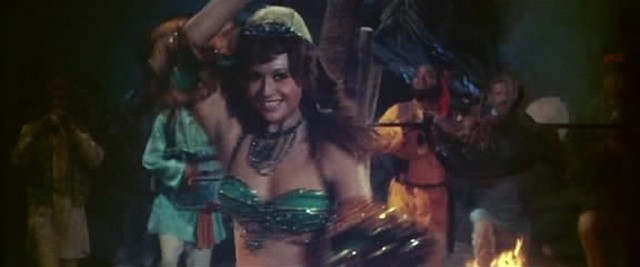Helen and I
by Sarah Sahim

Growing up half-Indian, half-Afghan in a less-than-average English town mostly populated by white people meant I was never really able to be in touch with my ethnic cultures. The closest connection I developed was one forced upon just about every brown kid ever: Bollywood. I danced to Hoothon Pe Aisi Baat, wore out my Kuch Kuch Hota Hai and Dil To Pagal Hai videotapes, cried to Ek Pyaar Ka Nagma Hai, wondered how much Kajol restrained shivering as she stood in a lightweight sari on a crisp snowy mountain in the Swiss Alps while she was caressed by one of the Khans.
The entire Bollywood-watching populace is obsessed with the movie Sholay, a spaghetti Western-inspired masala film that even ran in some Indian theatres for years. The movie was my introduction to an item girl known mononymously as Helen.
An “item girl” is a seductress who often has a minor role — often a song — in a movie where she and a leading man would work together to make the leading lady jealous, or she may just have a cameo in one song which is used tirelessly to promote a film.
The concept of an item girl has been a subject of much contention in India. Item girls were crafted and developed for the male gaze, and some people, such as actress Shabana Azmi, have attributed it to the “sexualization of children”, but her justification lies in a familiar rhetoric: the notion that sexual liberation is always gratuitous and needs to be toned down. Seeing women celebrate their bodies is not something to avoid — women’s bodies belong to the women themselves and no one else.
Famous for her work in Bollywood movies throughout the 1960s and 1970s, Helen approached her roles with her own definition of seduction; a scrappy elegance that was a big middle finger to the clean, pure, beehived, cat-eyed, plain-sari wearing leading lady so often seen in films of this era. The notion of “purity” and “modesty” in a woman and particularly their clothing was imposed on India by the British Raj. Helen came out of nowhere — the antithesis of the ‘respectable’ lady — like an explosion of sparkly eyeshadow and allure.
I would like to share with you — whether you know Helen or are a complete newbie — five of my favourite Helen numbers.
Mehbooba Mehbooba
Sholay, 1975
As mentioned earlier, this song was my introduction to Helen. If R.D. Burman’s nasal singing doesn’t draw you in, then she most certainly will. The song exhibits an air of evil seduction — she’s dancing for the bad guys here! It’s dramatic, sexy, raw, and encapsulating. The longer you look at Helen, the more outrageous and ravishing she becomes.
Karle Pyar Karle
Talash, 1969
I believe this song earned Helen the right to be praised as a cabaret dancer. She cements herself as the bad-ass seductress who owns every single moment on camera and every single man on screen. Her flaxen blonde wig somehow complements the huge red feathers, gold embellishments, and crystallized tights that Hedi Slimane referenced in 2013.
O Haseena Zulfonwale
Teesri Manzil, 1966
This is a fun one. The leading man, Shammi Kapoor, enlists some help to try and win over the woman of his affections. In comes Helen with ruffles, feathers, shimmery rara dresses, sequins, and wigs galore, ready to assist.
Yeh Mera Dil Yaar Ka Deewana
Don, 1978
This might be one of her more reserved outfits, and that’s really saying something. Her look here is more in line with the contemporary and classic view of sensuality, but unlike the previous songs, this features her character in a private setting. Read: the dancing gets even more intense. And yes, that synth in the intro you recognized was sampled in that Black Eyed Peas #classic, Don’t Phunk With My Heart.
Piya Tu Ab To Aaja
Caravan, 1971
I saved this one for last because it is the ultimate Helen jam. Holy Mother of God. That scraggly, mousy brown hair, SO MANY SEQUINS, the modesty panel that’s completely the wrong colour, that insane eye makeup — now I have an unparalleled understanding and appreciation of green eyeshadow.
This song was naughty — “Monica, oh my darling!” is sung by the sleazy, good-for-nothing husband of the leading lady, a man cheating on her with Helen — hence the cutaways to a lady sitting on her own in a restaurant looking confused. R.D. Burman embedded the sleaziness of the scene with the signature rhythmic and sensual breathing that frames the song perfectly. Those dance moves? Even more perfect.
There was something so striking and enticing about Helen; the opulence of her outfits, the way her body moved, her expressions, her seductive sassiness. There was an audaciousness to her magnetism. She wasn’t supposed to be the star of the show, but her five-minute appearances possessed the ability to make or break a film.
I never felt particularly beautiful in my brown skin; I’ve always been a loud, outspoken person who said shit women weren’t supposed to say. I was conditioned to believe the latter wasn’t a ‘beautiful trait’ — that reserved, quiet, white women are more desirable. Helen taught me to say “FUCK YOU!” to those who want a woman to be quiet and stay quiet.
Sarah Sahim is a freelance writer based in the West Midlands. She cohosts the intersectional feminist podcast Not All Women and tweets about rappers, the Kardashians, and white dudes. You can legally stalk her here.